The global long wave infrared supercontinuum laser market is valued at USD 106.4 million in 2025 and is expected to reach USD 280.9 million by 2035, reflecting a CAGR of 10.2% and an absolute increase of USD 174.5 million over the period. This growth highlights a total expansion of 164.1%, with the overall market size likely to grow by nearly 2.64X. Market fundamentals remain strong, driven by the rising adoption of advanced spectroscopic solutions, increasing deployment of precision optical systems in defense and homeland security, and expanding applications in biomedical research and environmental monitoring. End users are investing heavily in systems offering broad spectral coverage, high stability, and consistent performance, pushing the demand for supercontinuum lasers across multiple sectors during 2025 to 2035.
The period between 2025 and 2030 is expected to see the long wave infrared supercontinuum laser market climb from USD 106.4 million to USD 156.9 million, adding USD 50.5 million in value. This growth phase, representing 28.9% of the decade’s total expansion, will be shaped by an increasing need for advanced optical characterization platforms and laser-based sensing solutions. The surge in demand for high-power, broadband laser systems for research laboratories, defense testing, and optical communication fields will significantly influence adoption. Enhanced capabilities such as spectral range flexibility, precise wavelength stability, and integration with ultrafast detection systems are expected to move from premium features to standard requirements in most research and industrial settings during 2025 to 2030.
The latter phase from 2030 to 2035 is projected to deliver even stronger growth, with the long wave infrared supercontinuum laser market expanding by USD 124 million, accounting for 71.1% of total decade-long expansion. This stage will be characterized by the widespread penetration of long wave infrared supercontinuum laser systems into mass-scale commercial applications. The growing integration of these systems with spectroscopy platforms, hyperspectral imaging, and advanced monitoring instruments will open new opportunities. Defense contractors will increasingly deploy these systems for threat detection and surveillance, while biomedical research organizations will apply them for imaging and diagnostics. Environmental agencies will rely on the precision of these lasers for pollutant detection and monitoring, particularly in atmospheric studies. The long wave infrared supercontinuum laser market will also see stronger adoption in material sciences and industrial inspection, where lasers enable more accurate defect detection and performance assessment of advanced materials during 2030 to 2035.
The decade ahead signals fundamental changes in the adoption patterns of high-performance laser technologies. Long wave infrared supercontinuum lasers will shift from being niche research tools to becoming integral solutions across defense, healthcare, and environmental monitoring domains. As technology matures, unit costs are expected to decline, broadening adoption across commercial and industrial end users. Regional opportunities will expand, with North America and Europe maintaining leadership in defense and healthcare applications, while Asia-Pacific emerges as a high-growth hub due to rising investments in research infrastructure and manufacturing.
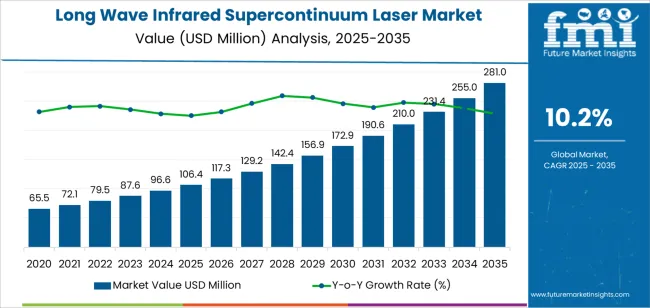
| Metric | Value |
|---|---|
| Estimated Value in (2025E) | USD 106.4 million |
| Forecast Value in (2035F) | USD 280.9 million |
| Forecast CAGR (2025 to 2035) | 10.2% |
From 2030 to 2035, the long wave infrared supercontinuum laser market is forecast to grow from USD 156.9 million to USD 280.9 million, adding another USD 124.0 million, which constitutes 71.1% of the overall ten-year expansion. This period is expected to be characterized by the expansion of coherent laser technologies, the integration of AI-powered beam control systems, and the development of multi-wavelength platforms with enhanced power efficiency capabilities.
The growing adoption of precision measurement practices will drive demand for long wave infrared supercontinuum lasers with superior coherence properties and compatibility with advanced detection systems across research and industrial applications.
Between 2020 and 2025, the long wave infrared supercontinuum laser market experienced robust growth, driven by increasing demand for advanced optical technologies and growing recognition of supercontinuum laser systems as essential tools for high-precision spectroscopic measurements across defense applications, biomedical research, and environmental monitoring sectors.
The long wave infrared supercontinuum laser market developed as researchers recognized the potential for these lasers to provide broad spectral coverage while maintaining high beam quality and enabling cost-effective measurement protocols. Technological advancement in fiber laser technologies and nonlinear optical processes began emphasizing the critical importance of maintaining spectral coherence and power stability in diverse research environments.
Market expansion is being supported by the increasing global demand for advanced optical measurement solutions and the corresponding need for laser systems that can provide superior spectral coverage and beam quality while enabling reduced measurement complexity and enhanced detection sensitivity across various research and industrial applications.
Modern research institutions and optical technology specialists are increasingly focused on implementing laser technologies that can deliver broad-spectrum illumination, prevent measurement artifacts, and provide consistent performance throughout complex experimental conditions and diverse application requirements. Long wave infrared supercontinuum lasers' proven ability to deliver exceptional spectral breadth against measurement challenges, enable time-efficient operations, and support cost-effective research protocols make them essential tools for contemporary optical research and precision measurement operations.
The growing emphasis on optical precision and advanced measurement capabilities is driving demand for long wave infrared supercontinuum lasers that can support high-resolution spectroscopic requirements, improve detection sensitivity outcomes, and enable automated measurement systems.
Researchers' preference for technology that combines effective spectral coverage with operational stability and measurement efficiency is creating opportunities for innovative laser implementations. The rising influence of precision optics and advanced measurement practices is also contributing to increased demand for long wave infrared supercontinuum lasers that can provide coherent illumination, real-time spectral monitoring capabilities, and reliable performance across extended operational periods.
The long wave infrared supercontinuum laser market is poised for rapid growth and transformation. As industries across defense, biomedical research, environmental monitoring, and precision manufacturing seek solutions that deliver exceptional spectral coverage, beam quality, and measurement precision, long wave infrared supercontinuum lasers are gaining prominence not just as specialized equipment but as strategic enablers of modern optical research and advanced measurement practices.
Rising precision measurement adoption in Asia-Pacific and expanding optical technology initiatives globally amplify demand, while manufacturers are leveraging innovations in fiber laser systems, nonlinear optical processes, and integrated beam control technologies.
Pathways like high-power laser platforms, AI-powered beam optimization systems, and specialized application solutions promise strong margin uplift, especially in defense and biomedical research segments. Geographic expansion and technology integration will capture volume, particularly where local research capabilities and precision measurement adoption are critical. Regulatory support around optical technology advancement, measurement accuracy requirements, and research efficiency standards give structural support.
The long wave infrared supercontinuum laser market is segmented by type, power output, application, end-use sector, and region. By type, the long wave infrared supercontinuum laser market is divided into narrow-band and wide-band categories. By power output, it covers low power (≤10W), medium power (10-50W), and high power (≥50W). By application, the long wave infrared supercontinuum laser market includes biomedical, environmental monitoring, national defense security, material characterization, spectroscopy research, and others. By end-use sector, it is categorized into research institutions, defense organizations, healthcare facilities, and industrial manufacturers. Regionally, the long wave infrared supercontinuum laser market is divided into North America, Europe, East Asia, South Asia & Pacific, Latin America, and the Middle East & Africa.
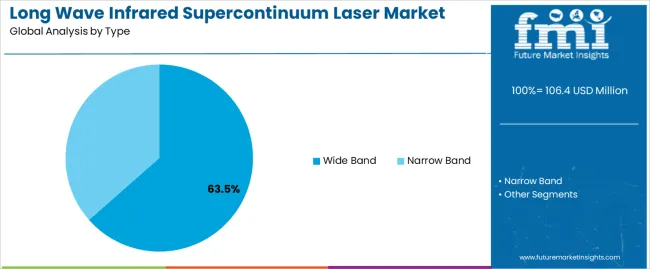
The wide band segment is projected to account for 63.5% of the long wave infrared supercontinuum laser market in 2025, reaffirming its position as the leading technology category. Research institutions and measurement laboratories increasingly utilize wide band supercontinuum lasers for their superior spectral coverage capabilities when operating across diverse measurement applications, excellent coherence characteristics, and versatility in applications ranging from spectroscopy to advanced optical characterization. Wide band supercontinuum laser technology's advanced spectral breadth capabilities and enhanced power efficiency directly address the research requirements for comprehensive spectral analysis in high-precision measurement environments.
This technology segment forms the foundation of modern optical research operations, as it represents the laser type with the greatest spectral versatility and established market demand across multiple application categories and research sectors. Manufacturer investments in advanced fiber technologies and nonlinear optical processes continue to strengthen adoption among research institutions and measurement laboratories. With organizations prioritizing measurement precision and spectral coverage optimization, wide band supercontinuum lasers align with both performance requirements and research efficiency objectives, making them the central component of comprehensive optical measurement strategies.
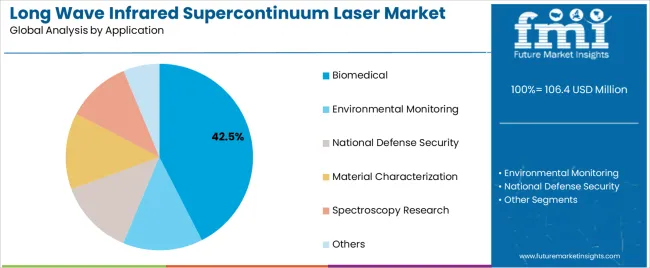
Biomedical applications are projected to represent 42.5% of long wave infrared supercontinuum laser demand in 2025, underscoring their critical role as the primary research consumers of precision laser technology for optical coherence tomography, tissue imaging, and biomedical measurement applications. Biomedical researchers prefer supercontinuum lasers for their exceptional spectral coverage capabilities, high coherence operational characteristics, and ability to provide detailed tissue analysis while ensuring measurement accuracy throughout diverse diagnostic and research programs. Positioned as essential equipment for modern biomedical research operations, supercontinuum lasers offer both precision advantages and measurement versatility benefits.
The segment is supported by continuous innovation in coherent laser technologies and the growing availability of specialized measurement systems that enable high-resolution imaging with enhanced penetration depth and rapid diagnostic capabilities. Additionally, biomedical research institutions are investing in comprehensive laser systems to support advanced imaging utilization and diagnostic planning. As precision medicine demand becomes more prevalent and diagnostic accuracy requirements increase, biomedical applications will continue to dominate the end-use market while supporting advanced optical imaging utilization and diagnostic measurement strategies.
The long wave infrared supercontinuum laser market is advancing rapidly due to increasing demand for precision optical technologies and growing adoption of advanced measurement solutions that provide superior spectral coverage and beam quality while enabling enhanced detection sensitivity across diverse research and industrial measurement applications. However, the long wave infrared supercontinuum laser market faces challenges, including high system complexity, technical expertise requirements, and the need for specialized maintenance and calibration protocols. Innovation in coherent laser capabilities and AI-powered beam control systems continues to influence product development and market expansion patterns.
Expansion of Coherent Laser and Advanced Control Technologies
The growing adoption of coherent laser systems, AI-powered beam optimization algorithms, and machine learning-based spectral control is enabling manufacturers to produce advanced supercontinuum lasers with superior coherence capabilities, enhanced operational precision, and automated measurement protocol functionalities. Advanced coherent systems provide improved spectral quality while allowing more efficient measurement processes and consistent performance across various research applications and experimental conditions. Manufacturers are increasingly recognizing the competitive advantages of coherent laser capabilities for operational differentiation and premium market positioning.
Integration of Smart Optics and Data Analytics
Modern supercontinuum laser producers are incorporating IoT connectivity, cloud-based measurement management, and integrated spectral monitoring systems to enhance operational intelligence, enable predictive maintenance capabilities, and deliver value-added solutions to research customers. These technologies improve measurement efficiency while enabling new operational capabilities, including real-time spectral monitoring, measurement optimization tracking, and reduced operational overhead. Advanced data integration also allows manufacturers to support comprehensive measurement systems and research modernization beyond traditional manual measurement approaches.
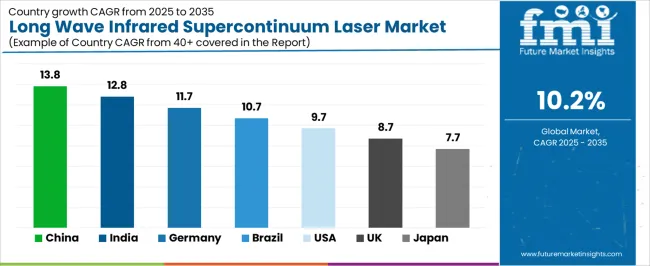
| Country | CAGR (2025 to 2035) |
|---|---|
| China | 13.8% |
| India | 12.8% |
| Germany | 11.7% |
| Brazil | 10.7% |
| USA | 9.7% |
| UK | 8.7% |
| Japan | 7.7% |
The long wave infrared supercontinuum laser market is experiencing strong growth globally, with China leading at a 13.8% CAGR through 2035, driven by the expanding optical technology programs, growing precision measurement adoption, and significant investment in laser technology development. India follows at 12.8%, supported by government initiatives promoting advanced optical research, increasing research infrastructure demand, and growing defense technology requirements. Germany shows growth at 11.7%, emphasizing precision optics innovation and advanced measurement technology development.
Brazil records 10.7%, focusing on research infrastructure expansion and scientific modernization. The USA demonstrates 9.7% growth, prioritizing optical technology standards and measurement precision excellence. The UK exhibits 8.7% growth, emphasizing optical research advancement and precision measurement development. Japan shows 7.7% growth, supported by high-tech optics initiatives and precision measurement concentration.
The report covers an in-depth analysis of 40+ countries top-performing countries are highlighted below.
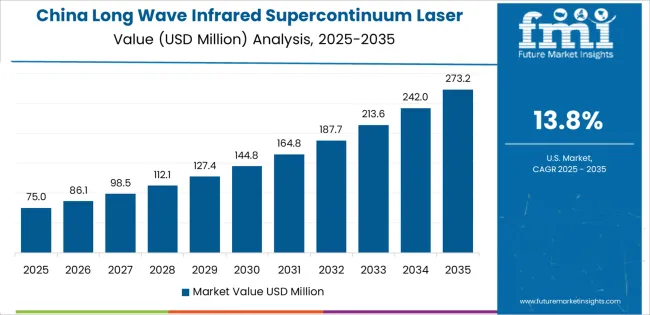
Revenue from long wave infrared supercontinuum lasers in China is projected to exhibit exceptional growth with a CAGR of 13.8% through 2035, driven by expanding optical technology programs and rapidly growing precision measurement adoption supported by government initiatives promoting advanced laser technology development. The country's strong position in photonics manufacturing and increasing investment in research infrastructure are creating substantial demand for advanced supercontinuum laser solutions. Major research institutes and technology companies are establishing comprehensive laser operation capabilities to serve both domestic measurement demand and optical technology markets.
Revenue from long wave infrared supercontinuum lasers in India is expanding at a CAGR of 12.8%, supported by the country's growing research sector, expanding government support for technology modernization, and increasing adoption of precision optical solutions. The country's initiatives promoting optical research and growing institutional awareness are driving requirements for advanced measurement capabilities. International suppliers and domestic manufacturers are establishing extensive production and service capabilities to address the growing demand for supercontinuum laser products.
Revenue from long wave infrared supercontinuum lasers in Germany is expanding at a CAGR of 11.7%, supported by the country's advanced precision optics capabilities, strong emphasis on optical technology innovation, and robust demand for high-performance laser systems in research and industrial measurement applications. The nation's mature research sector and precision-focused operations are driving sophisticated supercontinuum laser systems throughout the optical technology industry. Leading manufacturers and technology providers are investing extensively in coherent laser systems and precision measurement technologies to serve both domestic and international markets.
Revenue from long wave infrared supercontinuum lasers in Brazil is growing at a CAGR of 10.7%, driven by the country's expanding research sector, growing scientific institutions, and increasing investment in optical technology development. Brazil's research infrastructure expansion and commitment to technology modernization are supporting demand for efficient supercontinuum laser solutions across multiple research application segments. Manufacturers are establishing comprehensive service capabilities to serve the growing domestic market and research development opportunities.
Revenue from long wave infrared supercontinuum lasers in the USA is expanding at a CAGR of 9.7%, supported by the country's advanced optical technology sector, strategic focus on measurement precision, and established research capabilities. The USA's optical innovation leadership and technology integration are driving demand for supercontinuum lasers in defense applications, biomedical research, and advanced measurement services. Manufacturers are investing in comprehensive technology development to serve both domestic research markets and international specialty applications.
Revenue from long wave infrared supercontinuum lasers in the UK is growing at a CAGR of 8.7%, driven by the country's focus on optical research advancement, emphasis on measurement precision, and strong position in precision optics development. The UK's established optical innovation capabilities and commitment to research modernization are supporting investment in advanced laser technologies throughout major research regions. Industry leaders are establishing comprehensive technology integration systems to serve domestic research operations and specialty optical applications.
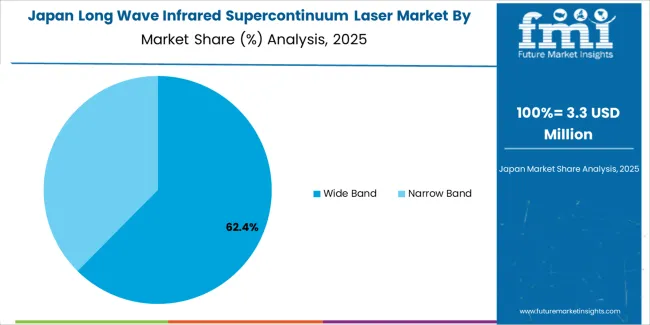
Revenue from long wave infrared supercontinuum lasers in Japan is expanding at a CAGR of 7.7%, supported by the country's high-tech optics initiatives, growing precision measurement sector, and strategic emphasis on optical technology development. Japan's precision technology capabilities and integrated optical systems are driving demand for advanced supercontinuum lasers in specialty research applications, precision manufacturing, and high-tech measurement applications. Leading manufacturers are investing in specialized capabilities to serve the stringent requirements of high-tech optics and precision measurement industries.
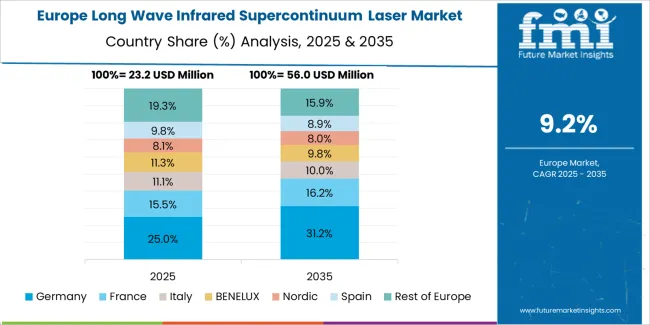
The long wave infrared supercontinuum laser market in Europe is projected to grow from USD 21.3 million in 2025 to USD 56.2 million by 2035, registering a CAGR of 10.2% over the forecast period. Germany is expected to maintain its leadership position with a 38.7% market share in 2025, declining slightly to 38.2% by 2035, supported by its strong precision optics sector, advanced optical technology capabilities, and comprehensive laser system industry serving diverse supercontinuum laser applications across Europe.
France follows with a 19.8% share in 2025, projected to reach 20.3% by 2035, driven by robust demand for supercontinuum lasers in defense applications, optical research programs, and precision measurement applications, combined with established optical technology infrastructure and research expertise. The United Kingdom holds a 17.5% share in 2025, expected to reach 17.8% by 2035, supported by strong optical research sector and growing precision measurement activities. Italy commands a 11.2% share in 2025, projected to reach 11.4% by 2035, while Spain accounts for 7.8% in 2025, expected to reach 8.0% by 2035.
The Netherlands maintains a 3.7% share in 2025, growing to 3.8% by 2035. The Rest of Europe region, including Nordic countries, Eastern Europe, Belgium, Poland, and other nations, is anticipated to maintain momentum, with its collective share moving from 1.3% to 0.5% by 2035, attributed to increasing research modernization in Eastern Europe and growing precision optics penetration in Nordic countries implementing advanced optical technology programs.
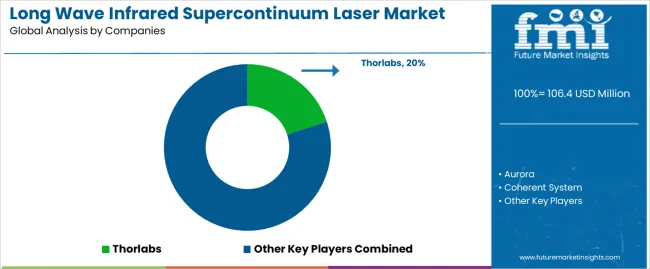
The long wave infrared supercontinuum laser market is characterized by competition among established laser manufacturers, specialized optical technology producers, and integrated precision measurement solutions providers. Companies are investing in coherent laser technology research, spectral coverage optimization, beam control system development, and comprehensive product portfolios to deliver consistent, high-performance, and application-specific supercontinuum laser solutions. Innovation in AI-powered systems, advanced fiber technologies, and operational efficiency enhancement is central to strengthening market position and competitive advantage.
Thorlabs leads the long wave infrared supercontinuum laser market with a strong market share, offering comprehensive supercontinuum laser solutions, including advanced coherent systems, with a focus on research and precision measurement applications. Aurora provides specialized optical laser capabilities with an emphasis on high-power systems and automated spectral control. Coherent System delivers innovative optical products with a focus on wide-band platforms and commercial research services. Axiom Optics specializes in precision optical systems and supercontinuum laser technologies for advanced research applications. Le VerreFluoré focuses on specialty optical equipment and integrated measurement solutions. Hymson Laser Technology Group offers specialized laser platforms with emphasis on industrial and research applications.
| Items | Values |
|---|---|
| Quantitative Units (2025) | USD 106.4 million |
| Type | Narrow Band, Wide Band |
| Power Output | Low Power (≤10W), Medium Power (10-50W), High Power (≥50W) |
| Application | Biomedical, Environmental Monitoring, National Defense Security, Material Characterization, Spectroscopy Research, Others |
| End-Use Sector | Research Institutions, Defense Organizations, Healthcare Facilities, Industrial Manufacturers |
| Regions Covered | North America, Europe, East Asia, South Asia & Pacific, Latin America, Middle East & Africa |
| Countries Covered | China, India, Germany, Brazil, United States, United Kingdom, Japan and 40+ countries |
| Key Companies Profiled | Thorlabs , Aurora, Coherent System, Axiom Optics, Le Verre Fluoré , and Hymson Laser Technology Group |
| Additional Attributes | Dollar sales by type and application category, regional demand trends, competitive landscape, technological advancements in coherent laser systems, spectral coverage development, AI integration innovation, and precision measurement integration |
The global long wave infrared supercontinuum laser market is estimated to be valued at USD 106.4 million in 2025.
The market size for the long wave infrared supercontinuum laser market is projected to reach USD 281.0 million by 2035.
The long wave infrared supercontinuum laser market is expected to grow at a 10.2% CAGR between 2025 and 2035.
The key product types in long wave infrared supercontinuum laser market are wide band and narrow band.
In terms of application, biomedical segment to command 42.5% share in the long wave infrared supercontinuum laser market in 2025.






Full Research Suite comprises of:
Market outlook & trends analysis
Interviews & case studies
Strategic recommendations
Vendor profiles & capabilities analysis
5-year forecasts
8 regions and 60+ country-level data splits
Market segment data splits
12 months of continuous data updates
DELIVERED AS:
PDF EXCEL ONLINE
Long-range Camera Market Forecast and Outlook 2025 to 2035
Long-Acting Beta-Agonists Market Size and Share Forecast Outlook 2025 to 2035
Long Term Evolution Base Station Market Size and Share Forecast Outlook 2025 to 2035
Long Term Post-Acute Care Software Market Size and Share Forecast Outlook 2025 to 2035
Long-term Care Software Market Size and Share Forecast Outlook 2025 to 2035
Long Haul Solutions Market Size and Share Forecast Outlook 2025 to 2035
Long-Acting Monoclonal Antibodies Market Insights – Trends & Forecast 2024-2034
Oblong Tub Lids Market Size and Share Forecast Outlook 2025 to 2035
Market Share Insights of Oblong Tub Lids Product Providers
Oblong Jar Market
Oblong Container Market
EU Longevity Supplements Sales Analysis Size and Share Forecast Outlook 2025 to 2035
Curcuma Longa (Turmeric) Root Extract Market Size and Share Forecast Outlook 2025 to 2035
Complementary and Alternative Medicine for Anti Aging & Longetivity Market Size and Share Forecast Outlook 2025 to 2035
Waveguide Components and Assemblies Market Size and Share Forecast Outlook 2025 to 2035
Wavefront Aberrometers Market Size and Share Forecast Outlook 2025 to 2035
Wavelength Division Multiplexing (WDM) Equipment Market Analysis - Size, Growth, and Forecast 2025 to 2035
mmWave Radar Module Market Size and Share Forecast Outlook 2025 to 2035
Microwave Source Market Size and Share Forecast Outlook 2025 to 2035
Microwave Monolithic Integrated Circuits Market Size and Share Forecast Outlook 2025 to 2035

Thank you!
You will receive an email from our Business Development Manager. Please be sure to check your SPAM/JUNK folder too.
Chat With
MaRIA